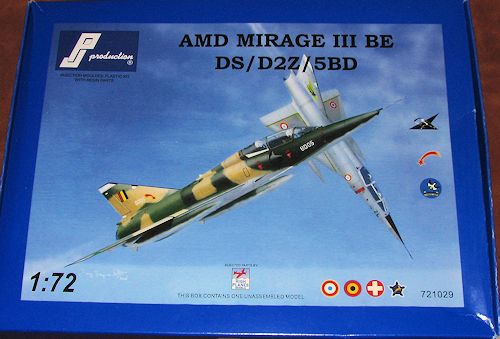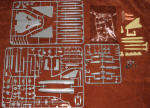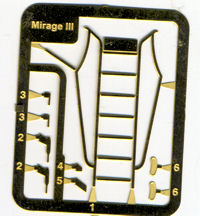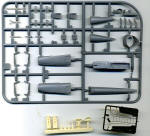
PJ Production 1/72 Mirage IIIBE/DS/D2Z/5BD
| KIT #: | 721029 |
| PRICE: | €29.80 from www.pjproduction.net |
| DECALS: | Four options |
| REVIEWER: | Scott Van Aken |
| NOTES: | Includes resin and photo etch parts |

| HISTORY |
While the Mirage IIIC was being put into production, Dassault was also considering a multirole/strike variant of the aircraft, which eventually materialized as the Mirage IIIE. The first of three prototypes flew on 1 April 1961.
The Mirage IIIE differed from the IIIC interceptor most obviously in having a 30 cm (11.8 in) forward fuselage extension to increase the size of the avionics bay behind the cockpit. The stretch also helped increase fuel capacity, as the Mirage IIIC had marginal range and improvements were needed. The stretch was small and hard to notice, but the clue is that the bottom edge of the canopy on a Mirage IIIE ends directly above the top lip of the air intake, while on the IIIC it ends visibly back of the lip.
Many Mirage IIIE variants were also fitted with a Marconi continuous-wave Doppler navigation radar radome on the bottom of the fuselage, under the cockpit. However, while no IIICs had this feature, it was not universal on all variants of the IIIE. A similar inconsistent variation in Mirage fighter versions was the presence or absence of an HF antenna that was fitted as a forward extension to the vertical tailplane. On some Mirages, the leading edge of the tailplane was a straight line, while on those with the HF antenna the leading edge had a sloping extension forward. The extension appears to have been generally standard on production Mirage IIIAs and Mirage IIICs, but only appeared in some of the export versions of the Mirage IIIE.
| THE KIT |
 One
thing that PJ Production is known for are their Mirage kits and conversions.
This particular kit continues their association with High Planes in Australia.
Basically High Planes provides the injected plastic bits while PJ Production
does the resin, photo etch and arranges for the decals.
One
thing that PJ Production is known for are their Mirage kits and conversions.
This particular kit continues their association with High Planes in Australia.
Basically High Planes provides the injected plastic bits while PJ Production
does the resin, photo etch and arranges for the decals.
It is pretty obvious when looking at the sprues that these are intended for all the different Mirage versions. You get a bunch of different noses and different fuel tanks along with other bits and pieces not used on the versions kitted.
The injected parts are actually rather well done. The engraving is a tad on the 'soft' side compared to Hasegawa, for example, but is still quite acceptable to the majority of modelers. The wings are pretty standard as Mirage kits go and the fin is a separate item. Also separate is the forward fuselage. This is to allow the two seat version to be kitted later. The clear sprue includes both the two seat canopy as well as two windscreens; one of them unframed.
 Of course,
there is resin. I have taken the liberty of using the previous Mirage 5 sprue to
show the basic kit, though there are quite a few new parts. The clear recce noses are not included. What is added to the resin
fit is a sprue that includes new bang seats and the newer instrumnent panels. An
additional photo etch boarding ladder is also included for the back seater. In
terms of plastic, there is an additional sprue that covers a considerable number
of items. This includes the new nose section, new cockpit tub
Of course,
there is resin. I have taken the liberty of using the previous Mirage 5 sprue to
show the basic kit, though there are quite a few new parts. The clear recce noses are not included. What is added to the resin
fit is a sprue that includes new bang seats and the newer instrumnent panels. An
additional photo etch boarding ladder is also included for the back seater. In
terms of plastic, there is an additional sprue that covers a considerable number
of items. This includes the new nose section, new cockpit tub new nose, new fuselage spine new exhaust housing and a number of other bits and
pieces. Some, like the seats, are duplicated in resin.
new nose, new fuselage spine new exhaust housing and a number of other bits and
pieces. Some, like the seats, are duplicated in resin.
Instructions are quite well drawn and let you know which of the optional bits are to be used for which set of markings. Color information is also provided during the build. There are four markings options. First is a Mirage 5 BD of 2 Squadron, Belgian AF from 1985 in the standard SEA camouflage scheme. Next a South African III D2Z from 1975 in their OD/Buff over Light Grey scheme. Third is a Swiss III DS from 1989 in their two tone grey scheme. The final option is an unpainted metal French plane from ECT 2/2 in 1982. The decals themselves are superbly done and free from registration issues.
| CONCLUSIONS |
I am quite pleased to see this two seater finally released. I have a penchant for these sorts of planes and am grateful to PJ Production for finally kitting this variant as it has been long desired by quite a few fans of the aircraft. Since it does include resin and photo etch, but not much of it, it would be a good kit for those just getting into using this material.
| REFERENCES |
http://en.wikipedia.org/wiki/Dassault_Mirage_5
http://en.wikipedia.org/wiki/Mirage_IIIE
February 2014 Thanks to PJ
Production
for the preview kit. You can find this kit
at
this link
If you would like your product reviewed fairly and fairly quickly, please contact the editor or see other details in the Note to Contributors.
Back to the Previews Index Page
particular set is designed for kit #721026 or the new #721029, though you could probably use it with other 1/72 Mirage IIIE/ER kits.
What it does is convert these kits to the latest MSIP update that was applied to the Mirage IIIEs of several countries. In this case, it is for the Swiss Mirages. As you can see, it is a multi-media set that includes a new fin, new canards, nose gear, nose gear door and a new cockpit/nose gear well. There are also new antennas, chaff dispenser and two new noses, one for the single seat S and another in clear resin for the RS. If doing the DS, you can use the nose that comes with that kit.
The photo etch fret includes a lot of antennas and strakes. Since it is their generic Mirage III set, you'll find a lot of bits not used. The set comes with complete instructions showing where all the pieces fit. There are no decals, but you should be able to glean what you need from the basic kit.
February 2014
My thanks to
PJ
Production
![]() for supplying the review set. You can order direct from the hyperlink.
for supplying the review set. You can order direct from the hyperlink.
If you would like your product reviewed fairly and fairly quickly, please contact me or see other details in the Note to Contributors.